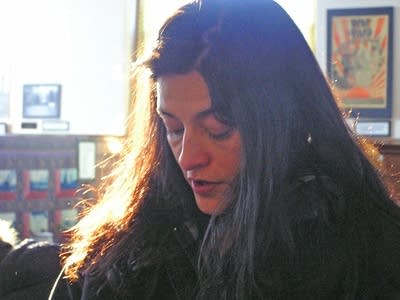Film crew revisits Indian boarding schools
Go Deeper.
Create an account or log in to save stories.
Like this?
Thanks for liking this story! We have added it to a list of your favorite stories.

"Older than America" is a Native American story, as told by a Native American company.
One of the scenes shot this week took place at the Carlton County Historical Society, an old Carnegie Library in downtown Cloquet. Over and over, an actor walked up to the building and entered the front door.

A camera crew filmed from the sunny front lawn, while other cast and crew prepared inside for additional takes.
"Older than America" is directed by Georgina Lightning, a veteran of movies like "Dream Keepers" and "Smoke Signals," and the television show The West Wing.
Turn Up Your Support
MPR News helps you turn down the noise and build shared understanding. Turn up your support for this public resource and keep trusted journalism accessible to all.
It features some of the better known Native American actors working today, including Adam Beach, Tantoo Cardinal, Wes Studi and Eric Schweig.
Christine Walker is executive producer. Last year she made the critically acclaimed movie, "Factotum," with Matt Dillon. Walker calls Minneapolis home, when she's not working in Los Angeles. Walker says the production company, Tribal Alliance, was formed to put Native Americans in front of, and behind the movie camera.

"There's a huge Native Indian acting community," Walker says. "But there aren't as many Native Americans who operate the cameras, or who are the directors or who are the producers. And so this company is set up specifically to create those opportunities."
Walker explains the story, which takes place in a contemporary Minnesota town where an Indian boarding school once stood. Off-reservation boarding schools were mandatory for many American Indian children from the late 1800s until the mid-20th century. Canada had a similar program.
"Hundreds and thousands of children were taken from their homes -- forcibly taken from their homes -- and put in Native Indian boarding schools," Walker says. "And the intent was to assimilate Native Americans to white culture."
The intent was to assimilate Native Americans to white culture. ... That's what these schools were trying to do -- take away what defines us.
The stories of abuse are well known. Some children died in the schools. Many others were emotionally scarred for life. There's a line in the film that says, "There are two ways to conquer a nation: you kill the people, or you take away everything that defines who and what they are."
"That's what these schools were trying to do -- take away what defines us," Walker says. "And what defines us are our customs, our language, our traditions -- those things that take us back and connect us to our ancestors and our history."
The boarding school story is personal for many on the set. Cody Lightning, 20, is a Northern Cree and the son of the director. He has a small part in this film, and he's also interning in the movie's art department. Lightning says the movie opens a painful wound for many of his people.
"A lot of the elders don't want to talk about what went on in boarding school," Lightning says. "And then there are others that are totally open and willing to share everything. It was pretty messed up. And the way it's just affected the generations; it was really poisoning in a lot of way."
Even the non-Indians are caught up in the story. Edward Cohen of Minneapolis is the movie's chief electrician.

"The story is about man's inhumanity to the Native Americans, when some of the settlers who came here and created school systems tried to strip the Indians of their heritage," says Cohen. "And they often did it in violent ways. And this film exposes that in a way that I don't think it's ever been exposed before."
Indian people will tell you the boarding school experience is still with them, years after the schools closed. It might be a factor in rampant suicide rates on many reservations, according to Producer Christine Walker.
"Our director -- her father, for instance, went to Native Indian boarding school and he committed suicide," Walker says.
But the movie's not all darkness. Walker says it's really about redemption.
"Georgina wanted to make a film about healing from that process, instead of just falling into the same sort of traps that her father did," says Walker.
The final scenes of "Older Than America" are being shot this weekend. When edited, the movie will be offered to film festivals like Sundance. It's expected to get a viewing in major markets and art houses. If it catches with the public, there could be a much wider distribution.





